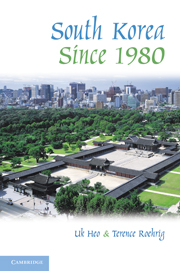Book contents
- Frontmatter
- Contents
- Dedication
- 1 Politics, Economics, and Foreign Relations before 1980
- 2 From Dictatorship to Democracy
- 3 Democratic Consolidation and Social Change
- 4 Economic Development and Financial Crisis
- 5 Economic Reform and the Korea–U.S. Free Trade Agreement
- 6 Inter-Korean Relations and the North Korean Nuclear Crisis
- 7 The South Korea–U.S. Alliance
- 8 South Korea and the Regional Powers
- Selected Bibliography
- Index
- References
5 - Economic Reform and the Korea–U.S. Free Trade Agreement
Published online by Cambridge University Press: 05 June 2012
- Frontmatter
- Contents
- Dedication
- 1 Politics, Economics, and Foreign Relations before 1980
- 2 From Dictatorship to Democracy
- 3 Democratic Consolidation and Social Change
- 4 Economic Development and Financial Crisis
- 5 Economic Reform and the Korea–U.S. Free Trade Agreement
- 6 Inter-Korean Relations and the North Korean Nuclear Crisis
- 7 The South Korea–U.S. Alliance
- 8 South Korea and the Regional Powers
- Selected Bibliography
- Index
- References
Summary
President Kim Dae-jung came to office in February 1998, only a few months after South Korea received its International Monetary Fund (IMF) bailout. Although President Kim won the 1997 presidential election by 1.6 percent, the slimmest margin of any previous South Korean presidential election, the Kim administration was in a much better position to implement reforms than was the previous Kim Young-sam administration. The political and economic environment had changed drastically in favor of reforms because of the financial crisis and the bailout. The IMF required the Kim government to implement reform policies to meet the conditions of the IMF bailout program. In addition, the new government under Kim Dae-jung's Millennium Democratic Party (MDP) had a close relationship with organized labor, making the labor sector more cooperative with the reform policies of the Kim Dae-jung government.
The first reform efforts by the Kim Dae-jung administration changed the government structure with a reorganization bill. The administration pointed to the Kim Young-sam administration's inadequate response to the warning signs of the 1997 crisis and attempted to improve the effectiveness and efficiency of the government in creating economic policy. With this bill, the Kim administration downsized the government and established the Planning and Budget Commission under the president's direct supervision for closer oversight of the economy.
The Kim government continued the reform drive with institutional and procedural reform to transform economic governance and meet the expectations of the IMF. With pressure from the IMF and the public, the long-stalled Bank of Korea (BOK) Act, part of the financial reform bill providing more autonomy from political control for the central bank, finally passed in the National Assembly on December 31, 1997.
- Type
- Chapter
- Information
- South Korea since 1980 , pp. 104 - 128Publisher: Cambridge University PressPrint publication year: 2010



